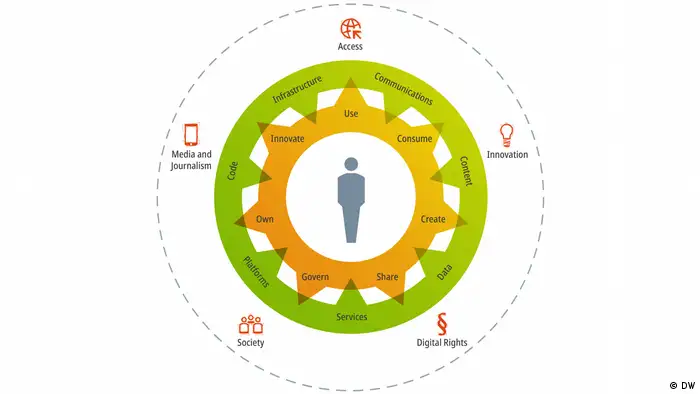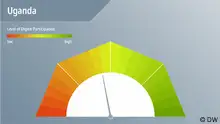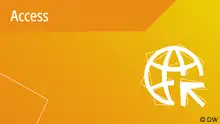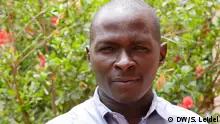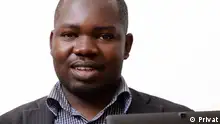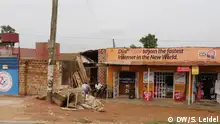#speakup barometer | Uganda
DW Akademie's model on digital participation
Digital participation is a complex and abstract matter. That's why we developed a model of digital participation that focuses on people and allows us to assess digital participation on a country basis.
To find a way to handle the complexity of digital participation and make it assessible, we developed a model focused on people. The model features a set of actions related to digital participation (orange circles in the center) and different areas of participation (green segments). One can combine any action with any field and come up with multiple readings: People own data, people share content, people use platforms, etc. The combination of actions with fields of participation illustrates the potential for participation on an abstract level. However, it says nothing about the actual levels of digital participation on a country basis. This is what we want to find out.
For that reason, we developed a method to describe digital participation in concrete ways and to assess it. The first step involved designating around 100 attributes to give us an indication of the level of digital participation in real life and examine what obstacles might exist. In a second step we clustered all attributes in thematic fields:
Access, Innovation, Digital Rights, Society, Media and Journalism.
- Access: The assessment of the “access” cluster comprises technical factors that influence digital participation. Further, the affordability of hard- and software is estimated, as well as the quality of infrastructure.
- Society: The assessment of the “society” cluster comprises social factors that influence digital participation, such as related effects of social norms or stereotypes.
- Innovation: The assessment of the “innovation” cluster focuses on the capacity to find new solutions in the realm of digital media and research, with a certain regard to open source and open knowledge.
- Digital Rights: The assessment of the “digital rights” cluster looks at the country’s legal system and jurisdiction and how they influence digital participation. Apart from legal norms, incidents like internet shutdowns play a role.
- Media and Journalism: The assessment of the “media and journalism” cluster analyzes the digital media landscape, including digital forms of journalism and citizen journalism.
We then integrated these five clusters into our model (dotted lines). This is important because digital participation always depends on environmental conditions, e.g. the quality of a country’s infrastructure determines if people can connect to the Internet and the diversity of the media and information eco-system is important in ensuring that all societal groups are represented in the media.
- Date 04.05.2018
- Author Julius Endert
- Feedback: Send us your feedback.
- Print Print this page
- Permalink https://p.dw.com/p/2xBDc
- Date 04.05.2018
- Author Julius Endert
- Send us your feedback.
- Print Print this page
- Permalink https://p.dw.com/p/2xBDc

